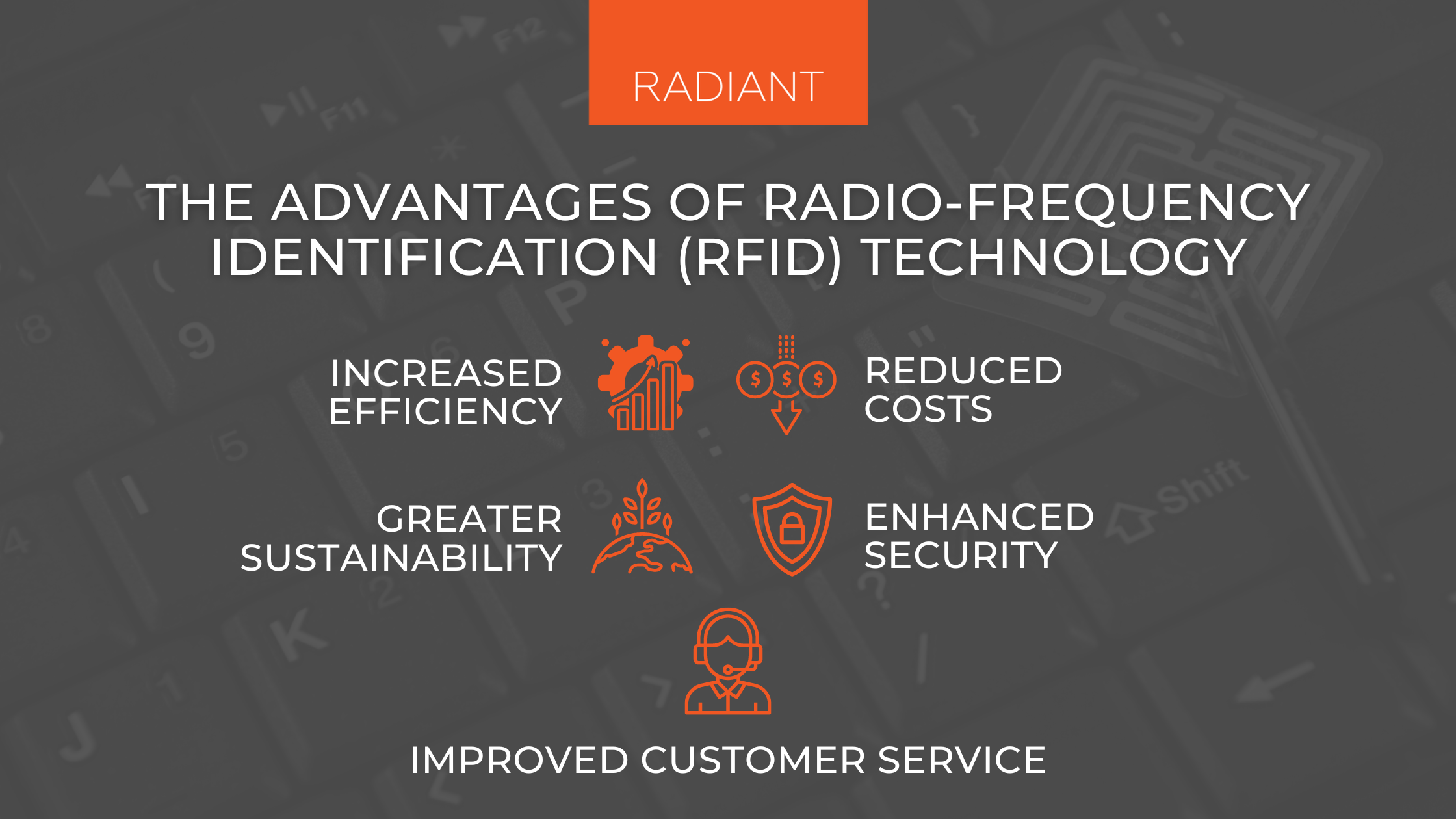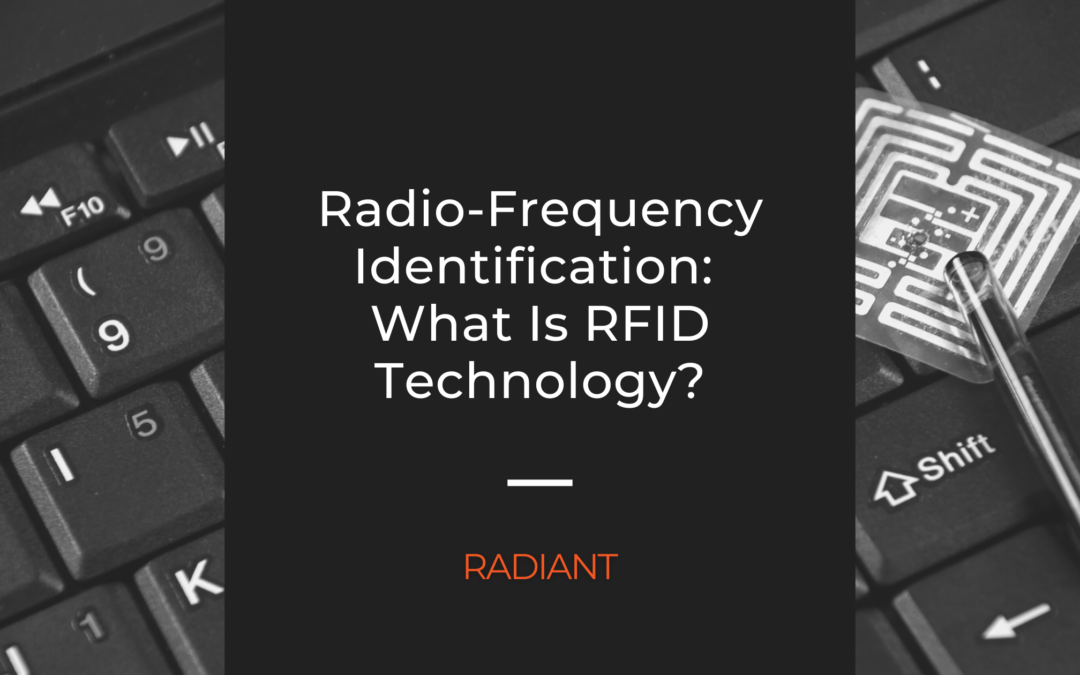Curious about Radio-Frequency Identification (RFID) technology and its potential to transform your business? You’re not alone.
An IoT technology increasingly attractive to businesses looking for ways to streamline processes, improve performance, and reduce operating costs, the global RFID market is projected to more than double by 2030.
In this blog post, we’ll delve into what makes RFID technology so useful for businesses and explore the innovative opportunities it presents for improving operational efficiency.
By understanding how this advanced form of barcode scanning works and which key features offer maximum benefit, you can determine whether investing in RFID technology is right for your organization’s needs.
What Is RFID Technology?
RFID technology, or Radio-Frequency Identification, is an automated tracking system that uses small asset tags to store and communicate data wirelessly.
It can be used for various purposes that require transmitting data, such as asset tracking and providing access control at security points.
RFID sensors, commonly referred to as RFID tags, contain a microchip with a coiled antenna that emits radio waves intercepted by readers to gain data from the tag, such as a serial number or another unique identifier.
This kind of technology has grown increasingly popular over recent years due to its efficiency. It can provide quick information and support different processes that have not been possible with traditional methods.
What Is the History of RFID Technology?
Radio-frequency identification (RFID) technology has been around since the 1940s and has had an incredibly diverse history.
The initial RFID application was used by the military, with the first noteworthy use being the tracking of military assets during World War II and later with the monitoring of military personnel.
After the war, RFID usage spread to other industrial sectors, such as logistics and supply chain management processes which helped to progress the technology to a higher operating frequency of 13.56 MHz.
In the early 1990s, the development of Ultra High Frequency (UHF) RFID led to its increased use in industries such as agriculture and manufacturing as a form of automation for inventory control and traceability purposes.
Today, this unique form of technology is increasingly being used in business due to its versatile nature. As technology continues to evolve in the years ahead, RFID systems will remain one of the leading methods for tagging data and processing information on a larger scale.
In What Ways Is RFID Technology Used In Business Today?
RFID technology is used for a number of applications in business settings.
Most notably, this technology enables businesses to track and monitor products or assets with unprecedented speed and accuracy. By equipping products or assets with “smart tags,” businesses can gain real-time visibility on their current location in the supply chain and ensure they are available when needed.
Additionally, RFID has the potential to create substantial cost savings by reducing losses due to theft, product recalls, and outages caused by inefficient asset management.
Furthermore, RFID works to boost security by adding biometric access control features to products or assets.
As a result, RFID technology offers businesses multiple opportunities for streamlining their operations and increasing efficiency.
How Does RFID Technology Work?
RFID technology is fundamentally a two-way communication between a reader and a tag via radio waves. There are two types of RFID tags: active and passive.
Passive RFID tags are the most common, which contain tiny electronic circuits that allow data to be transmitted wirelessly when the passive tag comes within range of the reader. They do not have an internal power source and instead draw energy from the reader that is scanning it in order to respond with its stored data.
When the RFID reader “interrogates” the passive RFID tag by sending out radio signals, the tag responds by sharing its stored data which the reader then collects and delivers to the processing system.
Active RFID tags, on the other hand, do contain a battery and can actively send data over an extended period of time. These types of tags can cost more, but they possess greater reading ranges since they aren’t reliant on ambient radio waves to be energized, giving them greater mobility capability.
RFID technology has many applications ranging from warehouse inventory management to object access control – making it an invaluable tool in modern-day operations.
What Are The Advantages Of Radio-Frequency Identification?
RFID technology is transforming the way businesses operate by providing an enormous range of advantages, including:

– Increased Efficiency
One of the primary advantages of radio-frequency identification (RFID) technology is that it can help businesses to operate more efficiently.
RFID tags can be attached to assets or inventory, and businesses can use RFID readers to track the real-time location of these items. This information can help businesses to optimize their inventory management and supply chain operations.
– Reduced Costs
Another advantage of RFID technology is that it can help businesses to reduce their costs.
For example, businesses can use RFID tags to track when products need to be replaced or serviced.
Additionally, RFID technology can be used to automate tasks such as stocktaking, which can lead to labor cost savings.
– Improved Customer Service
RFID technology can also be used to improve customer service.
For example, businesses can use RFID tags to keep track of customer orders and ensure that they are fulfilled in a timely manner.
Additionally, RFID tags can be used to track the location of products in a store, which can help customers find what they are looking for more quickly.
– Enhanced Security
Another advantage of RFID technology is that it can help businesses to enhance security.
For example, businesses can use RFID tags to track high-value assets such as equipment or tools.
Additionally, RFID tags can be used to track the location of employees in a building, which can help with emergency response planning.
– Greater Sustainability
Finally, radio-frequency identification technology can also help businesses to improve their sustainability practices.
For example, businesses can use RFID tags to track the lifecycle of assets and ensure that they are properly recycled or disposed of at the end of their useful life, helping to reduce their overall carbon footprint.
Are There Any Challenges Associated With RFID Technology?
Though radio-frequency identification technology offers undeniable benefits for businesses, there are some drawbacks to consider.
RFID implementation requires a substantial initial investment, including the cost of installing scanners and tags, training staff, and potentially hiring additional personnel.
Furthermore, RFID technology carries security vulnerabilities that must be guarded against in order to protect sensitive customer data.
Lastly, like any newer technology, the infrastructure of RFID may not always be reliable or compatible with existing systems.
Businesses should weigh these disadvantages carefully before making decisions about incorporating RFID technology into their operations.
How Can You Determine If RFID Technology Is Right For Your Business?
When considering whether radio-frequency identification technology is the right approach for a business, it is important to weigh cost versus benefits and consider the type of information that needs to be tracked.
This IoT technology can be expensive both in terms of equipment costs and labor since it requires special tags, readers, and software installations.
However, RFID tags provide businesses with an unparalleled level of asset control and visibility into their inventory, improving accuracy of data and allowing for more efficient tracking.
Additionally, using this kind of technology may reduce the amount of labor associated with repetitive manual tasks as data is collected quickly and accurately from remote locations.
For companies where security is a priority or tracking physical assets are important operations functions, RFID technology can provide an invaluable tool, but its far from the only tool available.
What Are The Alternatives For RFID Technology?
Radio-frequency identification is a technology that has become increasingly popular for its effective tracking capabilities, but it’s hardly the only option available.
Alternatives such as Near Field Communication (NFC), Bluetooth Low Energy (BLE), and Global Positioning System (GPS) are all viable alternatives for various applications.

- Near Field Communication (NFC): NFC is near field communication technology that allows wireless data transmission through electrical or magnetic fields within a short range of four inches or less.
- Bluetooth Low Energy (BLE): BLE stands for Bluetooth Low Energy, which is designed to consume low amounts of power so that battery life can be extended in connected devices. This enables larger scale data communication without the need to stay connected at all times. Additionally, BLE does not require a line of sight and can be read using existing devices, such as smart phones and tablets, helping to keep costs of deployment to a minimum.
- Global Positioning System (GPS): GPS uses satellites orbiting the earth in order to determine the position of tracked devices on earth. Although GPS is highly accurate, it is quite expensive and its use is limited in certain circumstances.
All three of these technologies have their own unique strengths and can often provide preferable solutions to RFID in certain scenarios and environments where radio-frequency identifcation may not be the best fit.
Still Not Sure If Radio-Frequency Identification Is Right For Your Business Needs?
After reading this blog post, you should have a clear understanding of RFID technology – what it is, how long it’s been around for, and some of the different ways that businesses are using it today.
You also know about its advantages and potential challenges so that you can make an informed decision about whether or not RFID technology is right for your business needs.
If you’re ready to move forward with radio-frequency identification, be sure to check out our RFID companies guide for evaluating providers.
However, if you’re still not sure if RFID technology is right for your business needs, don’t worry. We invite you to explore our RFID solution, in addition to our other technology offerings, then request your demo below so that you can explore the possibilities of IoT asset tracking first-hand with our team of experts.
Last Updated on January 20, 2023 by Radiant

